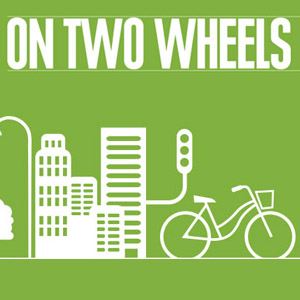On Two Wheels: Winter Cycling in Krakow, Part 2
Finally, winter has arrived. A month or two late, with no polar vortex like in the US, but with heavy snow and lots of ice. By the time you read this, it may well have already vanished, but if you haven’t stopped cycling – following my advice from a month ago – you now know everything you need about winter cycling. A few days with icy roads, slippery ruts and heavy snow is more than enough to learn. However, if you stashed your bike in the cellar, and still want to try it (and winter still is with us), don’t be afraid.
In the early 1990s, when I first discovered cycling, there were so few of us in Krakow that, in winter, I could tell who was out and about just from the tyre tracks in the snow. One winter day, cycling with friends, we discovered unknown tracks – a fellow cyclist we did not know! We followed the traces and found a new friend. Strangely enough, he was a subtropical expat – a Latin American student at the Jagiellonian University.
Today, it is common to see twenty or more bike tracks in the morning snow, and there’s no way to tell who created them. They are just winter cyclists, a new normality blending with the townscape of the 21st century. So, you may be curious about how to cope with the ice and snow on your bike.
The key is to take care of your front wheel: if it slips, there’s little you can do to recover. Don’t use your front brake, use the back brake softly and corner slowly. Flat, plain ice is not that dangerous, but anything icy and convex or concave can sling your wheel sideways. Beware of manholes – they tend to collect a build-up of ice. And beware of ice under snow. Dismounting is no shame – sometimes it’s just wise to get off (but remember that walking on ice can be more problematic than cycling).
I use low gears in the winter. Power pedalling may cause the bike to slip sideways because the force is applied to the pedals asymmetrically. Some riders ratchet down their saddles to lower the bike’s centre of gravity.
Many bike tires tend to be slippery in winter, so it may be wise to change at least the front one. A regular knobbly mud tire should work. I have also used spiked winter tires with success. They do add traction on ice, but don’t expect miracles. While many spiked tires are designed to run on dry surfaces too, certain types have enormous rolling resistance. Changing the whole wheel is much quicker and easier than changing a tire, so building a dedicated winter wheelset and switching according to the weather may be the best option.
If you keep your bike indoors, expect problems. Wheels and frames collect snow from the streets (if you use a trailer, a rare but practical add-on to the bike, you may unexpectedly bring a trailer-full of snow home). When it thaws, it usually turns out to be far from pure water, potentially flooding the floor with oils and other nasties from the street. You may need a mop and a bit of hard work after arriving home, or face confrontation with your partner, roommate or neighbors who are less enthusiastic about winter cycling.

